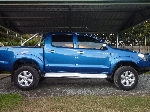Dual Batteries for dummies
Re: Dual Batteries for dummies
So may seem a stupid question, but does a DC-DC charger such as that one you posted Steve, replace the solenoid Such as the ABR one i posted? If so whats the difference, between a solenoid unit and a DC-DC charger?
-

Marshwa - Posts: 874
- Joined: Thu, 30 Oct 2008 10:48 +0000
- Location: Rockhampton, QLD
Re: Dual Batteries for dummies
Marshwa wrote:So may seem a stupid question, but does a DC-DC charger such as that one you posted Steve, replace the solenoid Such as the ABR one i posted? If so whats the difference, between a solenoid unit and a DC-DC charger?
No mate it does not.... it is just a charger. it will compenate for low input voltage and step it up to an accceptable level so as to charge you're chosen battery correctly. Something that the temp compenated alternator will not do.
It will boost charge the battery up to around the 14.5V- 14.9V range (depending on battery chemistry) for a while and hold it there, it will then drop the voltage a bit more and hold it there for about 10min or so, then it will come back to around the 13.5V mark and float the battery for ever on (This is where the ctek comes into it's own due to a solar panel input able to provide this for you while you are out fishing for the day
You will still require a solenoid to link the batteries together with some heavy gauge cable in order to winch and jump start
Ther main difference is Charger = WILL step up voltage but not supply more current than circuitry is designed to provide and will not pass mass current in either direction. Continuous duty solenoid = will NOT step up voltage, it is mearly a fancy way of saying "big f%$^king switch" It will pass mass amounts of current in either direction.
Here is RedArc's wiring diagram for exactly what I have minus the constant duty solenoid.
http://redarc.com.au/handy-hints/wiring ... tery-setup
Note that they have made some of the red cables from the main battery to the solenoid and out to the aux battery heavier, What this setup will do is remove your charger from circuit so that the current will pass through the solenoid... and not through the small componenets within. I hope this helps somewhat
I hope this is accurate
NLC
-

Steveyb - Posts: 1171
- Joined: Sun, 19 Jun 2011 5:50 +0000
Re: Dual Batteries for dummies
Ebay has the ctek 250s single (no solar input) for $250. Best price I can find yet. I'm in the process of duelling the batterys myself but I will be mounting the second one under the tray. It won't be linked the the primary battery at all. Never needed a jump start yet.....having said that. 
I don't travel alone but.
Cheers
Steve
I don't travel alone but.
Cheers
Steve
- Bushbasher
- Posts: 38
- Joined: Mon, 21 Mar 2011 2:56 +0000
Re: Dual Batteries for dummies
So do ABR, ARB and TJM kits come with these DC-DC Charger, or are the an addition item people add to a dual battery kit just to ensure each battery is being 100% charge. Are they a necessity or really just a luxury, to help to overall performance of the batteries?
What are the downfall if i don't run one of these and just stick with a solenoid?
What are the downfall if i don't run one of these and just stick with a solenoid?
-

Marshwa - Posts: 874
- Joined: Thu, 30 Oct 2008 10:48 +0000
- Location: Rockhampton, QLD
Re: Dual Batteries for dummies
They are just a luxury but a much better charging system, it will prolong the second batterys life. Which is good if you have forked out the big bucks for a gelcell.
- Bushbasher
- Posts: 38
- Joined: Mon, 21 Mar 2011 2:56 +0000
Re: Dual Batteries for dummies
OK thanks mate, i might start with the basics and a basic battery and upgrade a little later down the track if need be
-

Marshwa - Posts: 874
- Joined: Thu, 30 Oct 2008 10:48 +0000
- Location: Rockhampton, QLD
Re: Dual Batteries for dummies
I would like to add my opinions to this discussion:
I recently put a dual battery system in my 2010 SR5 Hilux. After alot of research and consideration, it consists of:
1) ARB dual battery tray
2) CTEK D250S Dual charger
3) Optima D34 yellow top Battery (55A-h)
I got the ARB dual battery tray because at the end of the day, there is only so much weight you can put on the wheel arch. There are some trays out there that say they can accommodate batteries larger than 100A-h. That’s a heavy bloody battery, and when you see they way the tray installs, just looking at it doesn't inspire confidence. Go for the known product, with the known backing, with the known reputation. I would strongly suggest you buy the tray from an ARB dealer, because if your wheel arches crack, I’m fairly confident ARB will help you out better than anyone else.
Forget about Redarc.! Their DC-DC chargers are aged technology and when you pay the dollars they ask for their products, you would expect to have the latest and greatest stuff. Also as some have mentioned, the Hilux alternator output is not enough to charge the primary battery, let alone an auxiliary battery to 100% state of charge, thus using a simple isolator is not going to do you any good for battery health. Batteries like to be at 100% state of charge, hence if you're already going to spend money on a dual battery system, I would strongly recommend you get a DC-DC charger capable of this. CTEK has a strong reputation for battery chargers, and the specs and features of the CTEK DC-DC charger absolutely whoops the Redarc. I got the D250S Dual from http://www.batteriesdirect.com.au cheaper than any online store was selling the Redarc BCDC1220.
BatteriesDirect is an authorised dealer for CTEK (I have been burnt before buying "genuine" products on eBay. Avoid it like the plague! What the emails floating around say is true: it's cheaper for a reason) and they are most definitely cheaper than buying it from any physical retailer/store in Australia. Plus, at the time of my purchase they offered free freight. I think they still do. You don't have to get the dual (with solar MPPT) and could save yourself some coin, but I did because I will use it in future to trickle charge the batteries when I’m away boating. Plus if you get the dual now, that means you only have to get a solar panel without a solar regulator, making the panel slightly cheaper. The advantage then with this is that your system is nicely integrated, where the CTEK D250S Dual will prioritise between the solar input and primary battery/alternator.
I got an Optima D34 battery because of its reputation and at a price I could not resist from a wholesaler who also sells to public at close to wholesale prices. But in general, any AGM battery is the go for dual purpose (deep cycle & cranking) use in 4wd'n. The Optima website will say that they can be discharged to 100% capacity, but be wary of this, despite them promoting this, this is really just marketing hype. You will kill ANY battery (Optima included) by discharging to 100%. Chargers like the CTEK will help maximise the life of any batteries used in deep cycle applications. To save coin once again, given what you were saying, you are more interested in cranking applications only, so you can get away with a standard lead acid battery. In any instance, check the CCA of the primary battery and try to get an auxiliary battery with a CCA in that ballpark.
These 3 items above set me back $790 in total. You will also need to get a small wiring kit for the CTEK installation, but JB Hifi or any car shop such as Repco or Supercheap can fix you up with an 8-gauge amp wiring kit that should do the job fine.
As someone has already mentioned, when it comes to cranking or jump-starting a dead battery, you can wire in any solenoid/isolator with a switch to connect the batteries in parallel. I had a SurePower isolator for this purpose, but with a recent safety recall, ARB replaced it with a Redarc smart isolator (don't shoot me for saying to forget about Redarc earlier!). All isolators pretty much work in the same way, so I’m fine with the Redarc in this instance. (Just note my comment earlier how buying from a reputable dealer will ensure you get looked after if issues arise...). This will set you back about another $170, and you will need to use heavier gauge cable for this install (probably around 2-gauge) so if having another isolator is not an option, why not use the charger to ensure your auxiliary battery is charged to 100% capacity, and then IF required, use a pair of jumper leads to get the car started. Just an idea for the interim.
When it comes to battery monitors, my opinion is to keep it simple. Most (not all) are just fancy voltmeters with red and green LEDs. If you want a proper battery monitor, look at Victron and Sinergex, these come with shunts required to accurately measure the battery's state of charge, but expect to pay $400-$500 for one of these. I don't have any type of battery monitoring installed, and in your case, I would just keep a voltmeter handy. As a general rule of thumb, when no load is being drawn and the batteries are not being charged, any voltage around 13.5V indicates a fully charged battery (Green LEDs), and a voltage around 10.0V indicates a fully depleted battery (Red LEDs). Batteries due to be changed will struggle to hold a constant floating voltage, often not reaching above 13.0V, and this is the warning sign that your battery is on its way out and will need to be replaced soon.
Hope this gives you some guidance in designing your dual battery system.
I recently put a dual battery system in my 2010 SR5 Hilux. After alot of research and consideration, it consists of:
1) ARB dual battery tray
2) CTEK D250S Dual charger
3) Optima D34 yellow top Battery (55A-h)
I got the ARB dual battery tray because at the end of the day, there is only so much weight you can put on the wheel arch. There are some trays out there that say they can accommodate batteries larger than 100A-h. That’s a heavy bloody battery, and when you see they way the tray installs, just looking at it doesn't inspire confidence. Go for the known product, with the known backing, with the known reputation. I would strongly suggest you buy the tray from an ARB dealer, because if your wheel arches crack, I’m fairly confident ARB will help you out better than anyone else.
Forget about Redarc.! Their DC-DC chargers are aged technology and when you pay the dollars they ask for their products, you would expect to have the latest and greatest stuff. Also as some have mentioned, the Hilux alternator output is not enough to charge the primary battery, let alone an auxiliary battery to 100% state of charge, thus using a simple isolator is not going to do you any good for battery health. Batteries like to be at 100% state of charge, hence if you're already going to spend money on a dual battery system, I would strongly recommend you get a DC-DC charger capable of this. CTEK has a strong reputation for battery chargers, and the specs and features of the CTEK DC-DC charger absolutely whoops the Redarc. I got the D250S Dual from http://www.batteriesdirect.com.au cheaper than any online store was selling the Redarc BCDC1220.
BatteriesDirect is an authorised dealer for CTEK (I have been burnt before buying "genuine" products on eBay. Avoid it like the plague! What the emails floating around say is true: it's cheaper for a reason) and they are most definitely cheaper than buying it from any physical retailer/store in Australia. Plus, at the time of my purchase they offered free freight. I think they still do. You don't have to get the dual (with solar MPPT) and could save yourself some coin, but I did because I will use it in future to trickle charge the batteries when I’m away boating. Plus if you get the dual now, that means you only have to get a solar panel without a solar regulator, making the panel slightly cheaper. The advantage then with this is that your system is nicely integrated, where the CTEK D250S Dual will prioritise between the solar input and primary battery/alternator.
I got an Optima D34 battery because of its reputation and at a price I could not resist from a wholesaler who also sells to public at close to wholesale prices. But in general, any AGM battery is the go for dual purpose (deep cycle & cranking) use in 4wd'n. The Optima website will say that they can be discharged to 100% capacity, but be wary of this, despite them promoting this, this is really just marketing hype. You will kill ANY battery (Optima included) by discharging to 100%. Chargers like the CTEK will help maximise the life of any batteries used in deep cycle applications. To save coin once again, given what you were saying, you are more interested in cranking applications only, so you can get away with a standard lead acid battery. In any instance, check the CCA of the primary battery and try to get an auxiliary battery with a CCA in that ballpark.
These 3 items above set me back $790 in total. You will also need to get a small wiring kit for the CTEK installation, but JB Hifi or any car shop such as Repco or Supercheap can fix you up with an 8-gauge amp wiring kit that should do the job fine.
As someone has already mentioned, when it comes to cranking or jump-starting a dead battery, you can wire in any solenoid/isolator with a switch to connect the batteries in parallel. I had a SurePower isolator for this purpose, but with a recent safety recall, ARB replaced it with a Redarc smart isolator (don't shoot me for saying to forget about Redarc earlier!). All isolators pretty much work in the same way, so I’m fine with the Redarc in this instance. (Just note my comment earlier how buying from a reputable dealer will ensure you get looked after if issues arise...). This will set you back about another $170, and you will need to use heavier gauge cable for this install (probably around 2-gauge) so if having another isolator is not an option, why not use the charger to ensure your auxiliary battery is charged to 100% capacity, and then IF required, use a pair of jumper leads to get the car started. Just an idea for the interim.
When it comes to battery monitors, my opinion is to keep it simple. Most (not all) are just fancy voltmeters with red and green LEDs. If you want a proper battery monitor, look at Victron and Sinergex, these come with shunts required to accurately measure the battery's state of charge, but expect to pay $400-$500 for one of these. I don't have any type of battery monitoring installed, and in your case, I would just keep a voltmeter handy. As a general rule of thumb, when no load is being drawn and the batteries are not being charged, any voltage around 13.5V indicates a fully charged battery (Green LEDs), and a voltage around 10.0V indicates a fully depleted battery (Red LEDs). Batteries due to be changed will struggle to hold a constant floating voltage, often not reaching above 13.0V, and this is the warning sign that your battery is on its way out and will need to be replaced soon.
Hope this gives you some guidance in designing your dual battery system.
- chevaps
- Posts: 61
- Joined: Mon, 16 Aug 2010 9:38 +0000
Re: Dual Batteries for dummies
Just wanna weigh back in and say... aged technology does not mean it's bad... in most cases it proves that it works....
Nothing wrong with simple charging methods... they work effectivly and provide less to go wrong. I would agree that having MPPT is a great benefit in conjuction with the solar input.. but you can't write something off just because it's "old"
NB: Batteries direct 369 for ctek (With solar)
I got my Redarc (genuine) for 320(with out obviously)
So the bang for buck is still to be had...
Also... battery gauges are a waste of time and money!!!


Nothing wrong with simple charging methods... they work effectivly and provide less to go wrong. I would agree that having MPPT is a great benefit in conjuction with the solar input.. but you can't write something off just because it's "old"
NB: Batteries direct 369 for ctek (With solar)
I got my Redarc (genuine) for 320(with out obviously)
So the bang for buck is still to be had...
Also... battery gauges are a waste of time and money!!!
Last edited by Steveyb on Thu, 22 Sep 2011 10:04 +0000, edited 1 time in total.
NLC
-

Steveyb - Posts: 1171
- Joined: Sun, 19 Jun 2011 5:50 +0000
Re: Dual Batteries for dummies
I believe the Redarc dc-dc charger has a bulit in isolator unlike the ctek, they can't be too aged technology.
- felix
- Posts: 420
- Joined: Sun, 07 Jan 2007 12:00 +0000
- Location: , SA
Re: Dual Batteries for dummies
felix wrote:I believe the Redarc dc-dc charger has a bulit in isolator unlike the ctek, they can't be too aged technology.
The CTEK D250S Dual does have a built in isolator.
- chevaps
- Posts: 61
- Joined: Mon, 16 Aug 2010 9:38 +0000
Re: Dual Batteries for dummies
Steveyb wrote:Just wanna weigh back in and say... aged technology does not mean it's bad... in most cases it proves that it works....
Nothing wrong with simple charging methods... they work effectivly and provide less to go wrong. I would agree that having MTTP is a great benefit in conjuction with the solar input.. but you can't write something off just because it's "old"
Steveyb wrote:So the bang for buck is still to be had...
Not going into the finer details of the construction of these chargers and the components used, for the purposes of this discussion, when I say aged technology, i had features and bang for your buck in mind.
For example, the CTEK has 5 stages for the charging cycle, where as the the Redarc has 3 stages. 3 Stages is probably enough because as you say, older technology proves it works and in most cases there is less to go wrong. Redarc probably has the mentality, if it aint broke, don't fix it. Come to think of it, Redarc sounds a bit like Toyota in this instance, and we are still buying Hiluxes thick and fast
One other thing i will note, is that current and voltage ripple in battery chargers is not a good thing (ripple is the AC in the DC) because it heats the battery, and the CTEK does have lower ripple (both voltage and current), despite only being a few percent lower, it was still enough to sway me over to the CTEK.
Steveyb wrote:Also... battery gauges are a waste of time and money!!!

Couldn't agree more!! Hence why i had to say it.
- chevaps
- Posts: 61
- Joined: Mon, 16 Aug 2010 9:38 +0000
Re: Dual Batteries for dummies
Chevaps,
I full agree AC ripple is no good, but yeah you are splitting hairs there 5 stage charging!! WTF does joe in his hilux need all this for? is my kinda point
5 stage charging!! WTF does joe in his hilux need all this for? is my kinda point
In my work, we maintain 17 communiacation sites from lismore to rocky all of which have battery charging and distribution systems either maintained by us or the user of the equipment paying us rental.. could be QPS, Q RAIL, ASA, QAS, QFRS etc etc... and you know what... bulk, absorb and float, this is all that is needed in reality, this has been at the heart of making sure when you call 000 during a storm and we have lost our main feed to a site that the comms gear keeps running (way more important than the milk getting warm)

 .. the rest of this rubbish about max power point tracking is really about marketing and trying to gain better sales against oposition than anything else, though I admit it works better than the power matching requirements of PWM.
.. the rest of this rubbish about max power point tracking is really about marketing and trying to gain better sales against oposition than anything else, though I admit it works better than the power matching requirements of PWM.
But you what.... at the end of the day the only thing that matters is 'HiLUx happiness' and getting new toys for her.
I full agree AC ripple is no good, but yeah you are splitting hairs there
In my work, we maintain 17 communiacation sites from lismore to rocky all of which have battery charging and distribution systems either maintained by us or the user of the equipment paying us rental.. could be QPS, Q RAIL, ASA, QAS, QFRS etc etc... and you know what... bulk, absorb and float, this is all that is needed in reality, this has been at the heart of making sure when you call 000 during a storm and we have lost our main feed to a site that the comms gear keeps running (way more important than the milk getting warm)
But you what.... at the end of the day the only thing that matters is 'HiLUx happiness' and getting new toys for her.
NLC
-

Steveyb - Posts: 1171
- Joined: Sun, 19 Jun 2011 5:50 +0000
Re: Dual Batteries for dummies
Ohhhh and.... now that we have HIJacked your question Marshwa, has this been helpful? Bahahahahahaha 

NLC
-

Steveyb - Posts: 1171
- Joined: Sun, 19 Jun 2011 5:50 +0000
Re: Dual Batteries for dummies
hey guys
i've been looking into putting in a battery system for the last couple of weeks for different options and setups
i was reading every thing chevaps said he did and went and to a 4wd store in hobart and told them what others had done using the ctek chargers
i was told that if i used the D250S i would have to use the the smartpass unit along with it.
is this right???
what does the smartpass unit actualy do?
makes for a pricey unit altogether
i've been looking into putting in a battery system for the last couple of weeks for different options and setups
i was reading every thing chevaps said he did and went and to a 4wd store in hobart and told them what others had done using the ctek chargers
i was told that if i used the D250S i would have to use the the smartpass unit along with it.
is this right???
what does the smartpass unit actualy do?
makes for a pricey unit altogether
-

06ToyluxSR - Posts: 107
- Joined: Tue, 01 Mar 2011 11:26 +0000
Re: Dual Batteries for dummies
The only reason you would want the SmartPass is if you wanted to manage essential and non-essential loads.
I don't see it as necessary if you looking for a dual battery system for your HiLux.
If you have a caravan, campervan, or the like, then yes, it would be beneficial, but otherwise, no.
I don't see it as necessary if you looking for a dual battery system for your HiLux.
If you have a caravan, campervan, or the like, then yes, it would be beneficial, but otherwise, no.
- chevaps
- Posts: 61
- Joined: Mon, 16 Aug 2010 9:38 +0000
Re: Dual Batteries for dummies
it is true the when used together (the ctek 250s dual and smartpass). When you are trickle charging from solar or an external 240v charger, it will isolate Starter battery from the auxillery but will still pulse charge each battery?
- pete24186
- Posts: 11
- Joined: Sat, 10 Sep 2011 2:32 +0000
Re: Dual Batteries for dummies
I have just fitted a 250S dual to my setup before my last trip as I am now running two fridges. Very simple to set up and reasonably priced. You can add a solar panel without needing to add a regulator as well but dought I will ever need one.
Very happy with the unit
Very happy with the unit
On the internet you can be anything you want. It is strange that so many people choose to be stupid!
-

Alby - Posts: 6673
- Joined: Tue, 03 Jul 2007 1:00 +0000
- Location: Sydney, NSW
Re: Dual Batteries for dummies
I have installed dual batteries and a ctek 250s dual in my lux. I thought I'd post my thoughts and findings. Firstly very happy with it. The unit isolates the two batteries once once the voltage of the alternator batt drops below 12.8v(engine not running). Once charging the ctek does great stuff to the input voltage. That is, desulphates, plus outputs the best charge voltage despite the input voltage (5 charge stages), a temperature sensor allows for compensation in high temp.
Also as mentioned earlier it also has a second independended input for solar. (22v open circuit, 20A short circuit) which when used, not only maintenance charges the aux battery but ALSO the starter battery, this is a great feature!
Also as mentioned earlier it also has a second independended input for solar. (22v open circuit, 20A short circuit) which when used, not only maintenance charges the aux battery but ALSO the starter battery, this is a great feature!
- pete24186
- Posts: 11
- Joined: Sat, 10 Sep 2011 2:32 +0000
Re: Dual Batteries for dummies
pete24186 wrote:I have installed dual batteries and a ctek 250s dual in my lux. I thought I'd post my thoughts and findings. Firstly very happy with it. The unit isolates the two batteries once once the voltage of the alternator batt drops below 12.8v(engine not running). Once charging the ctek does great stuff to the input voltage. That is, desulphates, plus outputs the best charge voltage despite the input voltage (5 charge stages), a temperature sensor allows for compensation in high temp.
Also as mentioned earlier it also has a second independended input for solar. (22v open circuit, 20A short circuit) which when used, not only maintenance charges the aux battery but ALSO the starter battery, this is a great feature!
if you have a constant draw let's say 8 amps while driving what sort of voltage is the ctek putting into the 2nd battery?
- felix
- Posts: 420
- Joined: Sun, 07 Jan 2007 12:00 +0000
- Location: , SA
Re: Dual Batteries for dummies
felix wrote:pete24186 wrote:I have installed dual batteries and a ctek 250s dual in my lux. I thought I'd post my thoughts and findings. Firstly very happy with it. The unit isolates the two batteries once once the voltage of the alternator batt drops below 12.8v(engine not running). Once charging the ctek does great stuff to the input voltage. That is, desulphates, plus outputs the best charge voltage despite the input voltage (5 charge stages), a temperature sensor allows for compensation in high temp.
Also as mentioned earlier it also has a second independended input for solar. (22v open circuit, 20A short circuit) which when used, not only maintenance charges the aux battery but ALSO the starter battery, this is a great feature!
if you have a constant draw let's say 8 amps while driving what sort of voltage is the ctek putting into the 2nd battery?
This is dependant on ambient temperature as it has a direct impact on the internal impedance of the battery (put simply, when its hot, a lower voltage is required to fully charge the secondary battery, when its cold, higher volts), the Ctek 250ds provides this functionality at a constant output of 20Amps
I might be slow, but I'm rough.......
-

bill_i_am - Posts: 546
- Joined: Thu, 10 Jun 2010 9:52 +0000
- Location: Kingaroy
Who is online
Users browsing this forum: No registered users and 6 guests

